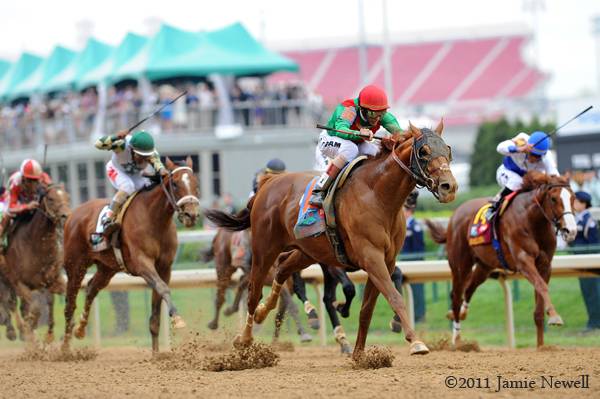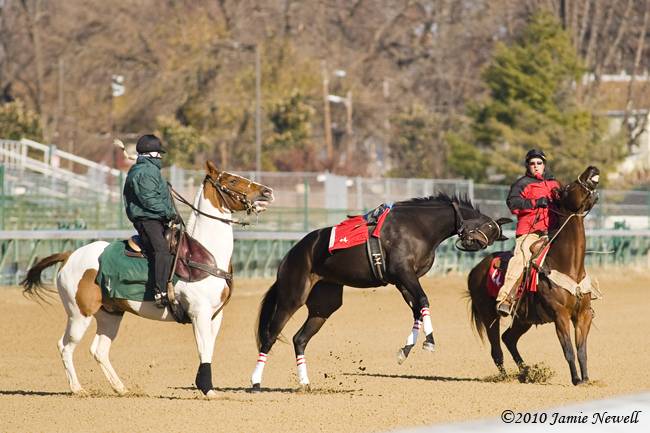 We are coming up on an anniversary of note. Though 2-year-old races have been running for several months now, late summer and early fall is one of the best times to start paying attention to these juvenile events. Some, like the Hopeful Stakes at Saratoga and the Del Mar Futurity, go so far as to give these tests grade I status, and naturally throw those contenders into the spotlight. But in recent years, more and more horses who go on to greater things don’t even see their first stakes race until they actually turn 3. Though it’s debatable on whether horses should wait until they’re older to begin a rigorous campaign, early sparks at 2 can hint at big things to come. It was in September of 2010 that a chestnut colt made his debut in a race at Arlington Park; though this maiden special weight was not heralded as anything particularly sensational, it marked the day our 2011 Kentucky Derby winner ran in his first race.
We are coming up on an anniversary of note. Though 2-year-old races have been running for several months now, late summer and early fall is one of the best times to start paying attention to these juvenile events. Some, like the Hopeful Stakes at Saratoga and the Del Mar Futurity, go so far as to give these tests grade I status, and naturally throw those contenders into the spotlight. But in recent years, more and more horses who go on to greater things don’t even see their first stakes race until they actually turn 3. Though it’s debatable on whether horses should wait until they’re older to begin a rigorous campaign, early sparks at 2 can hint at big things to come. It was in September of 2010 that a chestnut colt made his debut in a race at Arlington Park; though this maiden special weight was not heralded as anything particularly sensational, it marked the day our 2011 Kentucky Derby winner ran in his first race.
Animal Kingdom didn’t even win his maiden. The winner was Willcox Inn, who would eventually go on to glory in the Arlington Classic Stakes and Grade II American Derby. Ironically, it was Willcox Inn who was dubbed the “one to watch” during the gallop out. We know how differently their stories went from there. In this debut, Animal Kingdom broke a little awkwardly and ran at the back of the pack for most of the race, then rushed down the stretch like a loosed cannonball to get up for second. It was most definitely a move worth looking at again, and the sort of flash of talent you want to see in a young horse. Maiden specials for 2-year-olds at the longer distance of 1 1/16th-miles are also more irregular, and proved the strong finishers really could handle the distance. Animal Kingdom’s closing kick showed he could not only handle that, but even more.
There are no hard and fast rules about the best place to look for a future Derby horse. We have now seen horses come from not only the traditional dirt surface, but also the turf and now synthetics. Animal Kingdom didn’t have the experience of running a race over real dirt until the gates burst open in the Kentucky Derby. More recently, Big Brown (whose debut came on September 3, 2007) and Barbaro (who debuted on October 4, 2005) both came from turf backgrounds, but they proved their mettle over dirt before taking on that unknown factor. Since we cannot merely look at surface to determine where a potential Derby horse may turn up, can we really count out tracks, either? Barbaro’s debut came at Delaware Park, going 1 mile over the turf; he won that test by 8 ½ lengths. This race alone speaks volumes about how you can never tell where the next Derby winner is going to come from.
 Some racetracks come with the reputation of class. Saratoga, above all, is regarded as one of the single most competitive meets for a young horse, and so it would only make sense that many good juveniles can be seen at that track. Now that the meet is over, many of those will go on to Belmont, Monmouth, or on to Keeneland, depending on where the trainer is based. Later in the fall, promising juveniles hitched to big connections will turn up in Churchill Downs, Gulfstream, Fair Grounds, and Santa Anita. These tracks are a long ways from Delaware, you might say. Even more so is Calder, but that’s where the 2011 Forego winner debuted in 2010.
Some racetracks come with the reputation of class. Saratoga, above all, is regarded as one of the single most competitive meets for a young horse, and so it would only make sense that many good juveniles can be seen at that track. Now that the meet is over, many of those will go on to Belmont, Monmouth, or on to Keeneland, depending on where the trainer is based. Later in the fall, promising juveniles hitched to big connections will turn up in Churchill Downs, Gulfstream, Fair Grounds, and Santa Anita. These tracks are a long ways from Delaware, you might say. Even more so is Calder, but that’s where the 2011 Forego winner debuted in 2010.
What does all of this mean? Well, for one, take the results of all Grade I 2-year-old races with a grain of salt. Sure, it was only last year that Uncle Mo won the Grade I Champagne and the Breeders’ Cup Juvenile, but his only win for 2011 came in the ungraded Timely Writer Stakes. Not to speak poorly of Uncle Mo, but fewer horses in recent years have been able to transfer a brilliant juvenile campaign to age 3, when it’s time to get serious. (Unless you’re Lookin at Lucky, but he was a throwback.) Thus, I urge race fans to pay close attention to maiden special weights in this and the last months of 2011, with a lighter emphasis on graded stakes and more on what these juveniles are showing us. When you’re a 2-year-old Thoroughbred with barely, if any, experience, there is only the slightest difference between an allowance race and a Grade I stakes. After all, these are still babies we’re talking about—they can’t read the Daily Racing Form.








